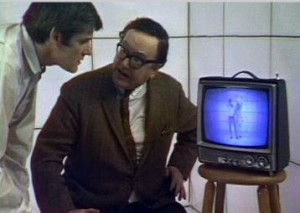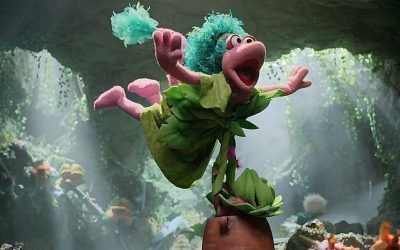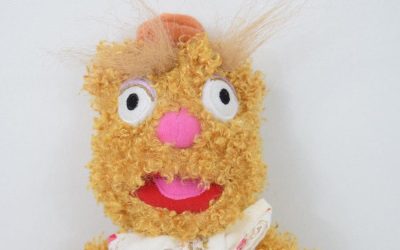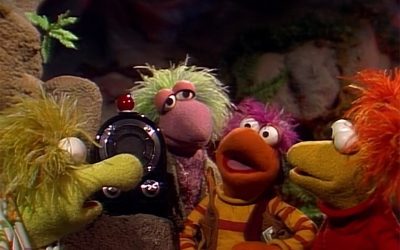Here at Tough Pigs, we’ve covered nearly every Christmas special Jim Henson and/or the Muppets ever made. But most of the non-holiday-related specials have been neglected until now. Each week, I’m joined by another Tough Pigs writer to watch a classic Muppet special that has nothing to do with Christmas.
Anthony: Last week, we shifted away from fairy tales with 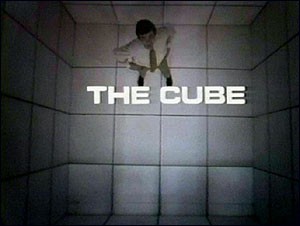 “Muppet Musicians of Bremen.” This week, we’re getting even farther away – we’ve jumped back to 1969 for “The Cube.” This special not only isn’t a typical Muppet romp, it doesn’t have any puppets in it at all. This is Jim Henson in full-on experimental mode, and with me to assess the results of that experiment is Matthew Soberman. Thanks for joining me, Matthew!
“Muppet Musicians of Bremen.” This week, we’re getting even farther away – we’ve jumped back to 1969 for “The Cube.” This special not only isn’t a typical Muppet romp, it doesn’t have any puppets in it at all. This is Jim Henson in full-on experimental mode, and with me to assess the results of that experiment is Matthew Soberman. Thanks for joining me, Matthew!
Matthew: Glad to help explore this grand experiment with you!
Anthony: So like I mentioned in the intro, “The Cube” is kind of an aberration for Jim Henson, at least among his long-form works.
Matthew: Exactly. It seems to me like this was the cap-off to a period when Jim was heading in two distinctively different directions, creatively. On one end, he had his Muppet works, and on the other end, he was doing some experimental, puppet-free works, like “Time Piece,” “Youth ‘68,” and of course, “The Cube.” Incidentally, right before Henson began filming “The Cube,” he filmed the pitch reel for the project that would ultimately create a permanent association between himself and puppetry: Sesame Street.
Anthony: So yeah, definitely a busy time for him. Thematically, “The Cube” is an extension of “Time Piece.” They’re both about the thin line between reality and illusion, and about how people are defined by constructs like time and space and the perceptions of others. But stylistically, they couldn’t be farther apart. “Time Piece” was 8 minutes long and filled with dozens (possibly hundreds) of quick cuts across various locations, while “The Cube” is almost a full hour, favors long shots, and is set entirely in a single room.
Matthew: True. It also feels like “Time Piece” is broader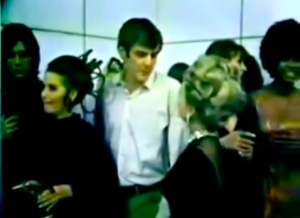 in its humor, while “The Cube,” while it’s not without its funny moments, isn’t really a comedy, though it is a satire.
in its humor, while “The Cube,” while it’s not without its funny moments, isn’t really a comedy, though it is a satire.
Anthony: Right. I think that’s mostly because of the limitations of the single-set format (and, to some extent, the state of television in 1969). With “Time Piece,” Jim had the luxury of making sure every shot told exactly the story he needed it to. The short has very little dialogue, and a lot of the humor comes from the juxtaposition of funny images. He can’t do that here – this is essentially a play for television, so he can’t count on the visuals. In their place, it’s a whole lot of people talking to each other about big, heady ideas.
Matthew: And isn’t that, in a sense, a reflection of the late 1960’s? It seems like challenging our known perceptions was very much part of the zeitgeist. I can’t really imagine a television network commissioning, or even airing, a program like this at any other time, even today.
Anthony: Definitely not. So now that we’ve talked about 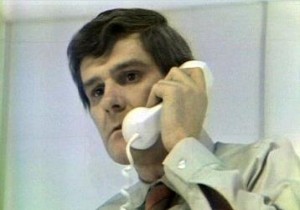 how of-the-moment it is, we should probably get into the actual story. An unnamed man (Richard Schaal, who will always be Carol’s boyfriend Chuck from The Bob Newhart Show to me) is trapped in an all-white room, and various other characters pass through to talk, argue, and mess with his mind.
how of-the-moment it is, we should probably get into the actual story. An unnamed man (Richard Schaal, who will always be Carol’s boyfriend Chuck from The Bob Newhart Show to me) is trapped in an all-white room, and various other characters pass through to talk, argue, and mess with his mind.
Matthew: I think that Schaal was a perfect choice for the unnamed Man. I definitely felt like I was going through this journey with him, and I found myself not knowing which way was up sometimes. Without Schaal, this show could’ve easily found itself falling into a cartoonish atmosphere.
Anthony: That performance is key. There’s so much going on here – from beginning to end, the show is just one big idea after another, and they all get paraded in front of Schaal. He strikes the perfect tone. He’s baffled at the situation he finds himself in, as any of us would be, and he stays relatable even when he starts fearing that he’s losing his mind. With a less talented actor, it could easily become insufferable. It’s really to his credit that I didn’t get tired or overwhelmed or bored after a half-hour.
Matthew: Precisely, it’s because Schaal comes off as so relatable that the ideas have any kind of staying power. When there are so many ideas coming at you like they are here, it becomes easy to start ignoring them.
Anthony: It also really helps that, for the most part, the characters we encounter are so vividly drawn. Do you have any particular favorites?
Matthew: My personal favorite is the rock band, if only 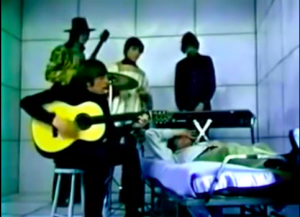 for the fact that they give me my favorite moment. For those who don’t know: the Man is quickly becoming frustrated, when a guitar player asks if he can rehearse in the Cube. They quickly develop a rapport, and the guitarist begins playing this song that seems profound, talking about the prisons of the mind and identity, and it all sounds so encouraging, all as the band begins assembling behind them, and when they hit the chorus, they begin singing about how the Man will never get out of the Cube and that he’ll die there. And then it gets really surreal, as we see that they’re actually lip-synching to a record, which begins skipping, so the band shrugs and leaves the room. It’s just a bit of that Muppet humor in such a heavy show.
for the fact that they give me my favorite moment. For those who don’t know: the Man is quickly becoming frustrated, when a guitar player asks if he can rehearse in the Cube. They quickly develop a rapport, and the guitarist begins playing this song that seems profound, talking about the prisons of the mind and identity, and it all sounds so encouraging, all as the band begins assembling behind them, and when they hit the chorus, they begin singing about how the Man will never get out of the Cube and that he’ll die there. And then it gets really surreal, as we see that they’re actually lip-synching to a record, which begins skipping, so the band shrugs and leaves the room. It’s just a bit of that Muppet humor in such a heavy show.
Anthony: Yeah, that’s a great one. I love how that sequence keeps building. And it’s a catchy song too, which is a plus.
My favorite sequence is when a man crawls in from the neighboring Cube, crazy from years of imprisonment and ranting about the comfort of squares and the removal of his thumbnails. It plays like a glimpse into a possible future for Schaal’s character – one that’s outside of the limited scope of this show, which takes place in real time. It’s a very chilling sequence, and our first hint that things could get really dark.
. . . And then Henson and Juhl brilliantly pull the rug out 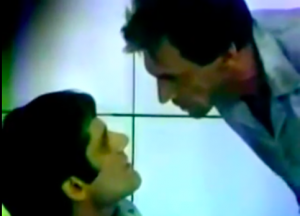 from under it, with the actor (Jack Van Evera – his actual name is referenced in dialogue) walking back in as himself to talk about how his character and how the torture stuff might be a bit much. He’s not a prisoner. He’s just an actor, exactly like Richard Schaal is. The whole thing is a house of cards. That leads into a bunch of other great stuff, but that moment really stands out for me.
from under it, with the actor (Jack Van Evera – his actual name is referenced in dialogue) walking back in as himself to talk about how his character and how the torture stuff might be a bit much. He’s not a prisoner. He’s just an actor, exactly like Richard Schaal is. The whole thing is a house of cards. That leads into a bunch of other great stuff, but that moment really stands out for me.
Matthew: And then they really pull down the fourth wall when they reveal that the whole thing is a television show, complete with happy ending, but the Man isn’t buying it. Even as the credits roll on the television screen, the Man claims that this so-called happy ending isn’t real. Come to think of it, if they really wanted to have an ending that ultimately has the Man leaving the Cube, and this is just me putting myself in Henson and Juhl’s shoes (we should all be so lucky!), I would’ve gone back to this idea at the end, exposing the nonexistent fourth wall. Then, I would bring Schaal in as himself, explaining to the Man that the Cube isn’t real, but then again, neither is he, and all he has to do is walk out, but by doing that, he will cease to exist. But I guess that would rob the show of its ambiguity.
Anthony: That’s an intriguing idea, although I really like the way it ends now. You mentioned that scene about halfway through where they show the ending, and while it isn’t quite the same ending, I really like that they stick to their guns and leave him in the Cube.
Really, I think The Cube is the best possible version of 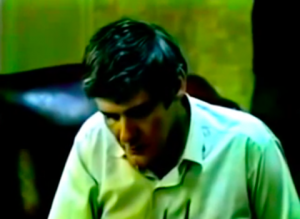 one of my least-favorite TV cliches – that episode every genre show used to do where the main character wakes up in our real world in a mental hospital because they talk about being on a genre show and of course genre shows don’t happen in real life. I’m thinking of things like Buffy’s “Normal Again” and Star Trek: TNG’s “Frame of Mind.” It’s always the same story, and it’s always stupid because we know that the show is going to continue and the fantasy/sci-fi setting will still exist. The Cube solves that problem by being a one-off, so it doesn’t have to worry about the next episode. For all we know, the Man really is crazy. He’s either crazy or he’s a TV character, and Henson/Juhl seem equally happy with either explanation.
one of my least-favorite TV cliches – that episode every genre show used to do where the main character wakes up in our real world in a mental hospital because they talk about being on a genre show and of course genre shows don’t happen in real life. I’m thinking of things like Buffy’s “Normal Again” and Star Trek: TNG’s “Frame of Mind.” It’s always the same story, and it’s always stupid because we know that the show is going to continue and the fantasy/sci-fi setting will still exist. The Cube solves that problem by being a one-off, so it doesn’t have to worry about the next episode. For all we know, the Man really is crazy. He’s either crazy or he’s a TV character, and Henson/Juhl seem equally happy with either explanation.
Matthew: Yeah, I think the purpose of “The Cube” is to raise questions, but not really give answers. Anything else would’ve made this less impactful.
Anthony: Yes! In that way, it reminds me a lot of the mysteries on LOST (or, to stick closer to the time period, The Prisoner). The point isn’t that things will be explained logically, it’s that the world presented is intriguing and weird and off-kilter.
Matthew: In a way, it’s sort of like a cartoon, minus a real plot, save for “get out of the Cube.”
Anthony: That’s true, and some of my favorite moments 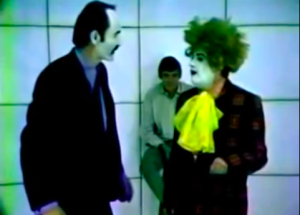 are the most cartoonish. You mentioned earlier that there’s not a whole lot of comedy, but what’s here is terrific. Things like Arnie the handyman’s four tons of chocolate rabbits (“14 years I’ve been here, and not one request!”) or the comedy team, a ghoulish Martin and Lewis knockoff in white facepaint. Their jokes are intentionally terrible, and very much in the classic Muppet tradition.
are the most cartoonish. You mentioned earlier that there’s not a whole lot of comedy, but what’s here is terrific. Things like Arnie the handyman’s four tons of chocolate rabbits (“14 years I’ve been here, and not one request!”) or the comedy team, a ghoulish Martin and Lewis knockoff in white facepaint. Their jokes are intentionally terrible, and very much in the classic Muppet tradition.
Until their laugh machine shuts off suddenly and they turn on the Man for not laughing at their jokes. That’s another thing that shouldn’t work but somehow does – the tone turns on a dime very often. Another great example is when the Man is seduced by a woman accurately called The Seductress, which contains a very funny and unexpected moment where she tries to give him a massage and he giggles about it, before shifting back into a straight-forward, effective seduction scene. Over and over again, Henson and Juhl show a real mastery of their script and tone.
Matthew: Henson and Juhl had definitely mastered the Muppet sense of humor by the late 1960’s. Another funny moment that we haven’t mentioned yet is when an African-American critic comes in and studies the Cube, calling it a “mausoleum to whiteness,” and a sickening display of white pride. The Man tries to explain that he didn’t have any choice in the matter, and that he’s desperate to leave. By this time, he’s been told that he can’t follow anyone out of the Cube because it’s not “his door.” So when the critic asks why he can’t leave with him, the Man says “because that’s your door!” And of course the audience knows what he means, but the critic sees it as a return to segregation. It’s just a great show of the protagonist talking himself into an awkward situation.
Anthony: That’s a great satirical moment. Similarly, the 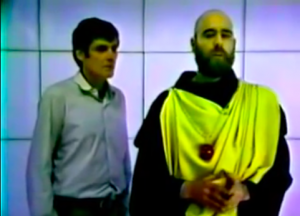 monk played by Jerry Nelson presents the man with a religious relic called the Ramadar, which makes a sound so annoying that the Man breaks it. Arnie the handyman shrugs and says that most people break them. They’ll drive you up the wall, but he’s got a whole room full of them. The implication is that religion is useless and annoying, or at least the physical artifacts of religion are. This is as close to cynical as Henson and Juhl ever got. Additionally, the monk’s dialogue is all vaguely spiritual nonsense, to the point that one of his lines was later reused for that most nonsensical of spiritual leaders, Cantus the Minstrel on Fraggle Rock.
monk played by Jerry Nelson presents the man with a religious relic called the Ramadar, which makes a sound so annoying that the Man breaks it. Arnie the handyman shrugs and says that most people break them. They’ll drive you up the wall, but he’s got a whole room full of them. The implication is that religion is useless and annoying, or at least the physical artifacts of religion are. This is as close to cynical as Henson and Juhl ever got. Additionally, the monk’s dialogue is all vaguely spiritual nonsense, to the point that one of his lines was later reused for that most nonsensical of spiritual leaders, Cantus the Minstrel on Fraggle Rock.
Matthew: Ah yes, “All is all. Is is.” Personally, I prefer Nelson’s take on Jack (of Jack Be Nimble) from Sesame Street: “Everything is everything!” For some reason, that doesn’t seem as cynical to me. All that we know is the known universe. Everything is everything. But then again, I didn’t live through the Sixties, so what do I know?
Anthony: You know that you’ll never get out ‘til you’re dead, dead, dead.
Matthew: And on that point, there’s a question I want to ask: how would you try to get out of the Cube?
Anthony: I’d probably turn the TV on and wait for the show to be rebroadcast so I could figure out how I was eventually going to leave it anyway. Either that or bribe the tutu-wearing gorillas to give me a ride out.
Matthew: Me, I see Arnie as being the key. Early on, he 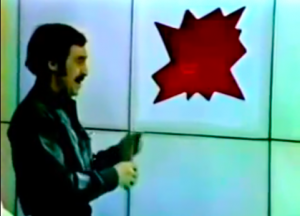 says that he can get the Man anything he needs. I would tell Arnie, “they forgot to put a knob on my door.” Knowing the cartoon logic of the Cube, either he would install the doorknob, or he’d just hand me one. Either way, you at least have a way of figuring out where your door is. Or I’d just ask the manager where my door is. The Man never thinks to ask.
says that he can get the Man anything he needs. I would tell Arnie, “they forgot to put a knob on my door.” Knowing the cartoon logic of the Cube, either he would install the doorknob, or he’d just hand me one. Either way, you at least have a way of figuring out where your door is. Or I’d just ask the manager where my door is. The Man never thinks to ask.
Anthony: Huh. That’s an excellent point. I think you might have just solved The Cube.
Matthew: Asking questions is a great way to figure stuff out. I know that because that little pitch reel Henson made before “The Cube” worked.
Anthony: Did it ever!
Next: Danny Horn joins me for The Fantastic Miss Piggy Show, which he somehow hasn’t covered on Tough Pigs until now.
Click here to confuse shellac and deodorant on the Tough Pigs Forum.
by Anthony Strand and Matthew Soberman

